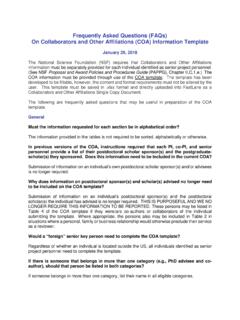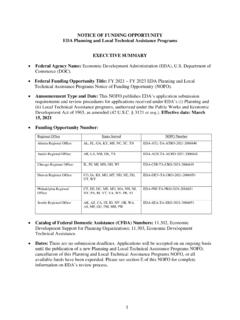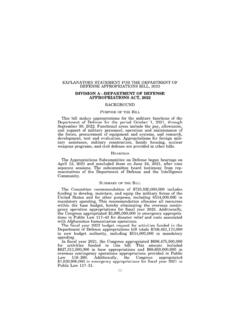Transcription of Improving Undergraduate STEM Education: Hispanic-Serving ...
1 Improving Undergraduate STEM Education: Hispanic-ServingInstitutions (HSI Program) PROGRAM SOLICITATION NSF 22-545 REPLACES DOCUMENT(S):NSF 20-599 National Science FoundationDirectorate for Education and Human Resources Division of Human Resource Development Division of Undergraduate EducationFull Proposal Deadline(s) (due by 5 submitter's local time): March 28, 2022 Track 1: Planning or Pilot Projects (PPP), Track 2: implementation and Evaluation Projects (IEP), and Track 3: Institutional TransformationProjects (ITP) full proposal deadline. August 31, 2022 Last Wednesday in August, Annually ThereafterTrack 1: Planning or Pilot Projects (PPP) and Track 3: Institutional Transformation Projects (ITP) full proposal deadline.
2 February 08, 2023 Second Wednesday in February, Annually ThereafterTrack 1: Planning or Pilot Projects (PPP), Track 2: implementation and Evaluation Projects (IEP) full proposal INFORMATION AND REVISION NOTESThis revision contains new submission due dates for Tracks 1, 2, and 3, and clarifying language stating the expectation that reviewers will review all the requireddocuments. All other program information remains the and migrating proposal preparation and submission capabilities from FastLane to is part of the ongoing NSF information technologymodernization efforts, as described in Important Notice No. 147 . In support of these efforts, research proposals submitted in response to this programsolicitation must be prepared and submitted via or via , and may not be prepared or submitted via proposal submitted in response to this solicitation should be submitted in accordance with the revised NSF Proposal & Award Policies & Procedures Guide(PAPPG) ( NSF 22-1 ), which is effective for proposals submitted, or due, on or after October 4, OF PROGRAM REQUIREMENTSG eneral InformationProgram Title: Improving Undergraduate STEM Education: Hispanic-Serving Institutions (HSI Program)Synopsis of Program.
3 The goals of the HSI program are to enhance the quality of Undergraduate science, technology, engineering, and mathematics (STEM)education and to increase the recruitment, retention, and graduation rates of students pursuing associate's or baccalaureate degrees inSTEM. Achieving these, given the diverse nature and context of the HSIs, requires additional strategies that support building capacity at HSIsthrough innovative approaches: to incentivize institutional and community transformation; and to promote fundamental research (i) on engagedstudent learning, (ii) about what it takes to diversify and increase participation in STEM effectively, and (iii) that improves our understanding ofhow to build institutional capacity at HSIs.
4 Intended outcomes of the HSI Program include broadening participation of students that are1 This document has been archived and replaced by NSF underrepresented in STEM and expanding students pathways to continued STEM education and integration into the HSI program is aligned with the National Science Board's vision for, and the NSF's commitment to, a more diverse and capable scienceand engineering ,2 HSIs are heterogeneous and unique in many Some HSIs have well-established undergraduateSTEM programs while others are just beginning to create STEM programs. Whether 2- year or 4- year , public or private, the HSIs serve a widerange of students with a diverse set of educational backgrounds.
5 The need for tailored initiatives, policies, and practices (mindful of socio-cultural awareness) should meet the students' needs and institutions' expectations while advancing Undergraduate students at HSIs towardhigher levels of academic achievement in STEM. This is the motivation behind three HSI program tracks: Track 1: Planning or Pilot Projects(PPP); Track 2: implementation and Evaluation Projects (IEP); and Track 3: Institutional Transformation Projects (ITP). Track 3, ITP, ismotivated by work on organizational identities for HSIs that suggest that organizational culture and identity play a key role in the success of anHSI in promoting student success in HSI program accepts proposals in the following tracks:Track 1: The Planning or Pilot Projects (PPP) track provides a funding opportunity for institutions that are new to NSF5 or arePrimarily Undergraduate Institutions (PUIs6), including community colleges.
6 The PPP has been designed to link with the other twotracks. The PPP track seeks to enhance Undergraduate STEM education and build capacity at less-resourced institutions and toincrease these institutions' ability to compete for NSF funding from other projects in this track undertake the activities necessary to develop a future HSI program Track 2 or Track 3 proposalsubmission. Pilot projects in this track may be carried out to achieve a short-term, well-defined goal to enhance the availability of high-quality Undergraduate STEM education at the HSI and gather preliminary data for future HSI program Track 2 or Track 3 , Pilot projects may also develop fundamental STEM education research capacity on student learning at HSIs, discoveringeffective means for diversifying and increasing participation in STEM.
7 All PPP projects must include project evaluation anddissemination 2: The implementation and Evaluation Projects (IEP) track supports the implementation of evidence-based unit-, department-,or multi-department-level activities that will enhance the quality of Undergraduate STEM education. All HSI institution types areencouraged to apply, especially PUIs (including community colleges). These projects may design and implement a new educationalpractice or practices, and/or adapt/replicate evidence-based practices that are already known to be may conduct research that promotes one or more of the HSI program goals, including research on indicators of effective andsuccessful Undergraduate STEM education at HSIs.
8 These projects must include both project evaluation and disseminationcomponents, as well as an education research component. The IEP strategies are expected to be institutionalized and 3: The Institutional Transformation Projects (ITP) track supports institution-wide structural or systemic changes to enhanceundergraduate STEM education at the proposing HSI. The ITP must be grounded in STEM education research and broadeningparticipation research and be designed to make institutional infrastructure and policy changes to support long-term institutional changesthat encourage and support faculty in implementing evidence-based practices that enhance student outcomes in STEM at theproposing the ITP track, research (including foundational research) that improves our understanding of how to build HSI institutionalcapacity in STEM is encouraged.
9 Such research should result in a strategic understanding about how the multiple components of theHSI program goals work synchronously to advance STEM education. All institution types are encouraged to apply, especially PUIs(including community colleges). Proposed activities can include adaptation of evidence-based strategies and/or the design andimplementation of innovative strategies. The ITP must include both project evaluation and dissemination components, as well as aneducation research component. The ITP proposed structural or systemic changes are expected to be institutionalized and sustained bythe tracks may support faculty research that is inter-, multi-, or trans-disciplinary, discipline-specific research, STEM education research,discipline-based STEM education research, or broadening participation research.
10 Research may be based at their home institution, an NSF-funded research center, another institution of higher education, and/or a national laboratory. Fundamental research is particularly encouragedon engaged student learning at HSIs, and on effectively diversifying and increasing participation in STEM at HSIs. Research-related fundsmay be requested for Undergraduate student research, supplies, equipment required to carry out the research, and faculty researchdevelopment faculty research should support the overarching goals of the HSI program which seek to improve and enhance undergraduateSTEM education, including Undergraduate student research experiences.













